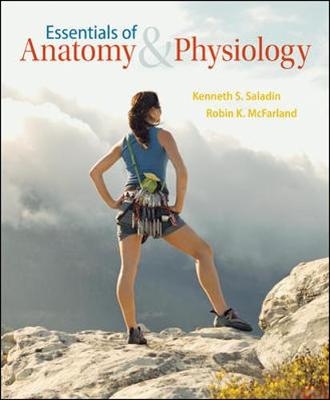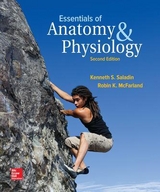
Essentials of Anatomy & Physiology
McGraw-Hill Professional (Verlag)
978-0-07-245828-2 (ISBN)
- Titel ist leider vergriffen;
keine Neuauflage - Artikel merken
Essentials of Anatomy & Physiologyis a text that blends up-to-date science, stimulating writing, high-quality art, and cutting-edge educational technology to provide the most effective teaching and learning program available in the one-semester anatomy and physiology courses.The distinctive pedagogy of the text revolves around the theme of “Elevate Learning”. From “Base Camp” to “Assess Your Learning Outcomes”, the student experiences a clear sense of the path ahead, a convenient means of charting progress, and a satisfying sense of accomplishment at the end.Essentials of Anatomy and Physiology has additional resources available in McGraw-Hill Education's ConnectPlus® and LearnSmart™, authored by Steve Sullivan to reflect the content and style of the textbook authors, and to help foster clarity for students.
Kenneth S. Saladin is Professor of Biology at Georgia College & State University in Milledgeville, Georgia, where he has taught since 1977. Ken teaches human anatomy and physiology, introductory medical physiology, histology, animal behavior, and natural history of the Galï¿pagos Islands. He has also previously taught introductory biology, general zoology, sociobiology, parasitology, and biomedical etymology. Ken is a member of the Human Anatomy and Physiology Society, American Association of Anatomists, American Physiological Society, Society for Integrative and Comparative Biology, and American Association for the Advancement of Science. He is the author of the best-selling textbooks Anatomy & Physiology: The Unity of Form and Function and Human Anatomy. Ken and his wife Diane have two adult children. Robin McFarland has taught anatomy and physiology at Cabrillo College in Aptos, CA since 1998. She earned a Ph.D. in physical (biological) anthropology from the University of Washington, where she studied the relationship between body fat and reproduction in primates. Robin collaborates on studies of ape anatomy with Adrienne Zihlman at the University of California, Santa Cruz. Robin is a member of the Human Anatomy and Physiology Society, American Association of Anatomists, and American Association of Physical Anthropologists. She was also contributing author to Human Anatomy, second edition, by Ken Saladin. She and her husband Jeff have two children, Reid and Madeleine. Robin enjoys hiking and climbing mountains with her family.
Chapter 1The Study of Anatomy and Physiology1.1 Anatomy—The Structural Basis of Human Function
1.2 Physiology—The Functional Relevance of Human Structure
1.3 The Human Body Plan
1.4 The Language of Medicine
Chapter 2Life, Matter, and Energy2.1 Atoms, Ions, and Molecules
2.2 Water, Mixtures, and pH
2.3 Organic Compounds
2.4 Energy and Chemical Reactions
Chapter 3Cytology—The Cellular Level of Organization3.1 The General Structure of Cells
3.2 The Cell Surface
3.3 The Cell Interior
3.4 The Life Cycle of Cells
Chapter 4Histology—The Tissue Level of Organization4.1 The Study of Tissues
4.2 Epithelial Tissue
4.3 Connective Tissue
4.4 Nervous and Muscular Tissues—The Excitable Tissues
4.5 Glands and Membranes
4.6 Tissue Growth, Development, Repair, and Death
Chapter 5The Integumentary System5.1 The Skin and Subcutaneous Tissue
5.2 Accessory Organs
Chapter 6The Skeletal System6.1 Skeletal Structure and Function
6.2 Bone Development and Metabolism
6.3 The Axial Skeleton
6.4 The Appendicular Skeleton
6.5 Joints
Chapter 7The Muscular System7.1 Muscular Tissues and Cells
7.2 Physiology of Skeletal Muscle
7.3 Cardiac and Smooth Muscle
7.4 Anatomy of the Muscular System
Chapter 8The Nervous System I—Nerve Cells, the Spinal Cord, and Reflexes8.1 Cells and Tissues of the Nervous System
8.2 The Physiology of Neurons
8.3 The Spinal Cord, Spinal Nerves, and Reflexes
Chapter 9The Nervous System II—The Brain, Cranial Nerves, and Autonomic Nervous System9.1Overview of the Brain
9.2Principal Divisions of the Brain
9.3Multiregional Brain Functions
9.4The Cranial Nerves
9.5The Autonomic Nervous System
Chapter 10The Sense Organs10.1Receptors and Sensations
10.2The General Senses
10.3The Chemical Senses—Taste and Smell
10.4The Ear—Hearing and Equilibrium
10.5The Eye and Vision
Chapter 11The Endocrine System11.1Overview of the Endocrine System
11.2Endocrine Physiology
11.3The Hypothalamus and Pituitary Gland
11.4Other Endocrine Glands and Tissues
11.5Stress Physiology
Chapter 12The Circulatory System I—Blood 12.1Introduction
12.2Erythrocytes
12.3Leukocytes
12.4Platelets
Chapter 13The Circulatory System II—Heart and Blood Vessels13.1Overview of the Cardiovascular System
13.2Gross Anatomy of the Heart
13.3Physiology of the Heart
13.4General Anatomy of Blood Vessels
13.5Physiology of Circulation
13.6Circulatory Routes and Blood Vessels
Chapter 14The Lymphatic System and Immunity14.1The Lymphatic System
14.2Nonspecific Resistance
14.3Features of Adaptive Immunity
14.4Cellular and Humoral Immunity
Chapter 15The Respiratory System15.1Functions and Anatomy of the Respiratory System
15.2Pulmonary Ventilation
15.3Gas Exchange and Transport
Chapter 16The Urinary System16.1Functions of the Urinary System
16.2Anatomy of the Kidney
16.3Glomerular Filtration
16.4Tubular Resorption and Secretion
16.5Water Conservation
16.6Urine Storage and Elimination
16.7Fluid, Electrolyte, and Acid–Base Balance
Chapter 17The Digestive System17.1Overview of the Digestive System
17.2The Mouth through Esophagus
17.3The Stomach
17.4The Liver, Gallbladder, and Pancreas
17.5The Small Intestine
17.6Chemical Digestion and Absorption
17.7The Large Intestine
Chapter 18Nutrition and Metabolism18.1Nutrition
18.2Carbohydrate Metabolism
18.3Lipid and Protein Metabolism
18.4Metabolic States and Metabolic Rate
18.5Energy Balance and Appetite Regulation
18.6Body Heat and Thermoregulation
Chapter 19The Reproductive System19.1Essentials of Sexual Reproduction
19.2The Male Reproductive System
19.3The Female Reproductive System
19.4The Production and Union of Sex Cells
19.5Pregnancy, Childbirth, and Lactation
Chapter 20Human Development and Aging20.1Fertilization and Preembryonic Development
20.2The Embryonic and Fetal Stages
20.3The Neonate
20.4Aging, Senescence, and Death
Appendix A: Answer Key Appendix B: Health Science Careers Appendix C: Symbols, Weights, and Measures Appendix D: Biomedical Word Roots, Prefixes, and Suffixes Glossary
| Erscheint lt. Verlag | 16.2.2014 |
|---|---|
| Zusatzinfo | 351 Illustrations, unspecified |
| Sprache | englisch |
| Maße | 234 x 279 mm |
| Gewicht | 1903 g |
| Themenwelt | Studium ► 1. Studienabschnitt (Vorklinik) ► Anatomie / Neuroanatomie |
| Studium ► 1. Studienabschnitt (Vorklinik) ► Physiologie | |
| ISBN-10 | 0-07-245828-3 / 0072458283 |
| ISBN-13 | 978-0-07-245828-2 / 9780072458282 |
| Zustand | Neuware |
| Haben Sie eine Frage zum Produkt? |
aus dem Bereich



